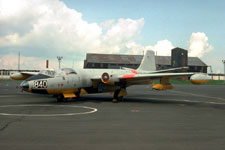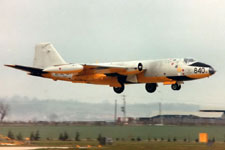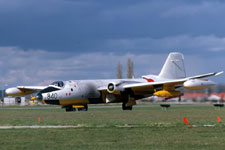| WK123's service history
Canberra WK123 was built by English Electric Aircraft Ltd as a B.2 bomber for the Royal Air Force. It was declared ready for collection in April 1954, and entered service with RAF 100 Sqn, a former Avro Lincoln Unit that had recently relocated to RAF Wittering from Kenya. Its stay with this Unit lasted 12 months, as it was transferred to Boulton Paul's Defford airfield for trials work in July 1955. Further flight trials were undertaken firstly with the Royal Radar Establishment (RRE) at Malvern between February and November 1956, and then later with the Aircraft and Armament Experimental Establishment (A&AEE) at Boscombe Down between December 1956 and April 1958. WK123 was then placed in long-term store with RAF 15MU (Maintenance Unit) RAF Wroughton, where it remained for the next nine years.
The aeroplane was subsequently transferred to the British Aircraft Corporation (BAC) factory at Warton airfield, moving there on 24th April 1967 to be overhauled and converted to TT.18 specification. This process was completed in May 1968, and WK123 was ferried to RAF 27MU RAF Shawbury for further storage, pending an RAF Squadron posting.
WK123 was instead transferred to the Royal Navy, and entered Fleet Air Arm service in September 1969 with the Fleet Requirements Unit (FRU) at Hurn.
At the same time, the aeroplane became the first TT.18 Canberra to enter Squadron service anywhere. Maintained under contact by Airwork Services Ltd, WK123 was assigned the fleet number '840' and employed on target facilities work from its Dorset base for the next three years. During the latter months of 1972, the FRU began to move its Canberra and Hunter fleets to RNAS Yeovilton, and WK123 had the distinction of being the last FRU aircraft to leave Hurn, on 29th November 1972. Two days later, the FRU was merged with the Air Direction Training Unit (ADTU) at Yeovilton, forming the new Fleet Requirements and Air Direction Training Unit (FRADTU).
The aeroplane continued in FRADTU service for a short time, as it was moved to RAF Aldergrove in Northern Ireland for a major inspection by 23MU in January 1973, returning to Yeovilton five months later. In mid-1974 the word 'Training' was dropped from FRADTU's title, and the Unit became known as FRADU, WK123 as '840' remained in service for the remainder of the decade, aside from another grounding for another major inspection at 23MU between August and December 1976. In February 1981, WK123 was ferried to BAC Salmesbury where it underwent a complete refurbishment, returning to FRADU, via St Athan in December 1982. It continued to give steady service until February 1987, when it was withdrawn from use and placed in long-term store at RAF St Athan.
WK123 was transferred back to the RAF in February 1988, where it rejoined its former Unit RAF 100 Sqn at RAF Wyton in Cambridgeshire. Refinished in RAF camouflage and assigned the codes 'CY', the aeroplane remained in service until January 1992, when it was acquired by the
German Air Force.
It was ferried by air to its new home at WDF 61, Ingolstadt and used as a source of spares. Indeed shortly after its arrival its wings were fitted to the Unit's Canberra B.2 99+34!
- December 2020
|

[© Dave Jones]

[© Bob Turner]

[© Bob Turner]
|